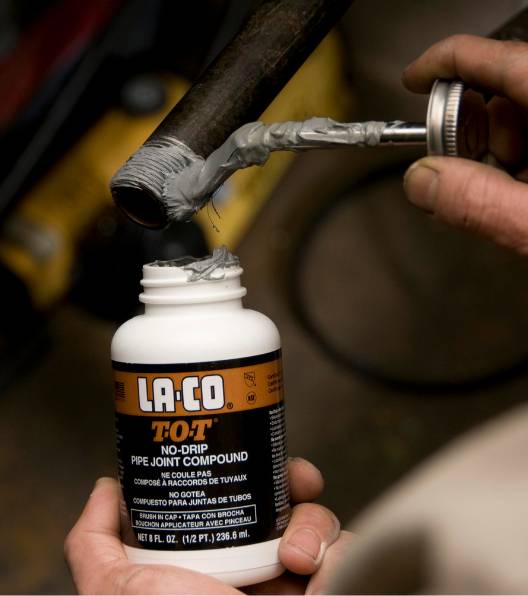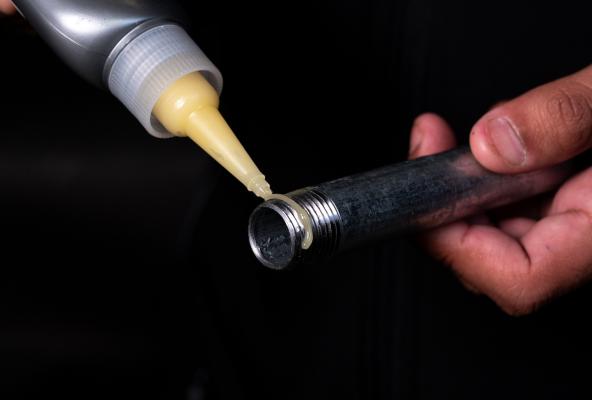
Favourites
Sign in to your account
By adding to Favourites, you can…
- Save products or resource documents you view regularly
- Save time with quick access to frequently viewed items
Please sign in or create an account to add to your Favourites.

Please sign in or create an account to add to your Favourites.
Thread-sealing compounds are usually solvent-based and work by hardening as the solvent evaporates. As solvent-based thread-sealing compounds present a risk of shrinking and cracking over time, they are best for sealing threads in maintenance applications where a permanent rigid bond is not essential.
Anaerobic thread sealants are high-performance sealants that only cure when oxygen is expelled. Anaerobic thread sealants such as Loxeal 58-11 are ideal for sealing permanent fixtures in commercial applications.
A liquid thread sealant or thread-sealing compound is recommended when sealing larger-diameter pipelines. For high-strength sealing on permanent structures, it's important to use a high-performance thread sealant such as the Loxeal®58-11. The Loxeal®58-11 is not only AGA-approved for use with gas, it is also WaterMark-approved for use with potable water.
For a detailed comparison, read our blog post here
SUPA-SEAL P.T.F.E Thread Seal Tapes, Loxeal Thread Sealants and LA-CO T-O-T and Slic-tite® Thread Sealing Compound can be used to seal pipes containing Natural Gas or LPG (propane).
Whilst Loxeal 18-10 is designed for medium-pressure gas applications, Loxeal 58-11 is designed for high-pressure gas and water applications.
| Properties | LOXEAL 58-11 High-Pressure Thread Sealant | LOXEAL 18-10 Medium-Pressure Thread Sealant |
|---|---|---|
| Viscosity @ 25°C | 24,000 - 70,000 mPa.s (high thixotropy^) | ≈45000 mPa.s (Thixotropic^) |
| Density @ 25°C | 1.05 g/ml | 1.0 g/ml |
| Max Diameter of Thread / Gap Filling Ability | M 80 / 3°/ 0.50mm | M 80 / 0.30mm |
| Flash Point | >100°C | Approximately 100°C |
| Solvent Content | None | None |
| Shelf Life @ 23°C | 2 Years | 2 Years |
| Temperature Range | -10°C to +150°C | -10°C to +150°C |
| AGA Approval | AGA-5048 | AGA-5047 |
| WaterMark Approval | WM-040164 | None |
| Maximum Working Pressure | 2000 kPa | 500 kPa |
| Handling Cure Time | 15 to 30 minutes | 20 to 40 minutes |
| Functional Cure Time | 1 to 3 hours | 1 to 3 hours |
| Full Cure Time | 3 to 6 hours | 5 to 10 hours |
| Shear Strength | 6 to 13 N/mm2 | 4 to 6 N/mm2 |
| Locking Torque Breakaway Prevailing | 18 to 24 N m 7 to 14 N m | 6 to 11 N m 2 to 5 N m |
| Elongation at Break | More than 100% | More than 100% |
Data stated is as tested on Bolt M 10x20 – quality 8.8. – Nut h – 0.8d.
No, it needs metal ions to cure.
No, do not use thread tape with it, or any other sealant. The thread tape will inhibit Loxeal from curing as the sealant needs metal to metal contact.
Recommended to use Loxeal 58-11 instead of Loxeal 18-10, as it has a higher strength and it takes longer to cure on stainless steel than other metals and the final strength is less than 100% of its full curing strength.
For disassembly, use normal tools and eventually heat pieces at 150/250°C (note: heating will likely produce carbon oxide and toxic fumes), remove any residue of cured product mechanically and clean parts with Acetone.
The sealant between the threads will harden when oxygen is expelled. The sealant outside of the piping will remain liquid as oxygen cannot be expelled.
The AGA approval has only been tested and approved for metal threads.
It has been approved for water according to American standards, but it is not Watermark approved for Australia.
Slic-Tite has a gritty texture due to PTFE materials and may have oil sitting on the top which should be mixed in before use.


Designed for plumbers front of mind, our thread sealants are designed to seal metal pipe threads, replacing the need for PTFE tape and yarn. For high-pressure applications, our Loxeal anaerobic thread sealants offer a no-mess solution.
View more categories